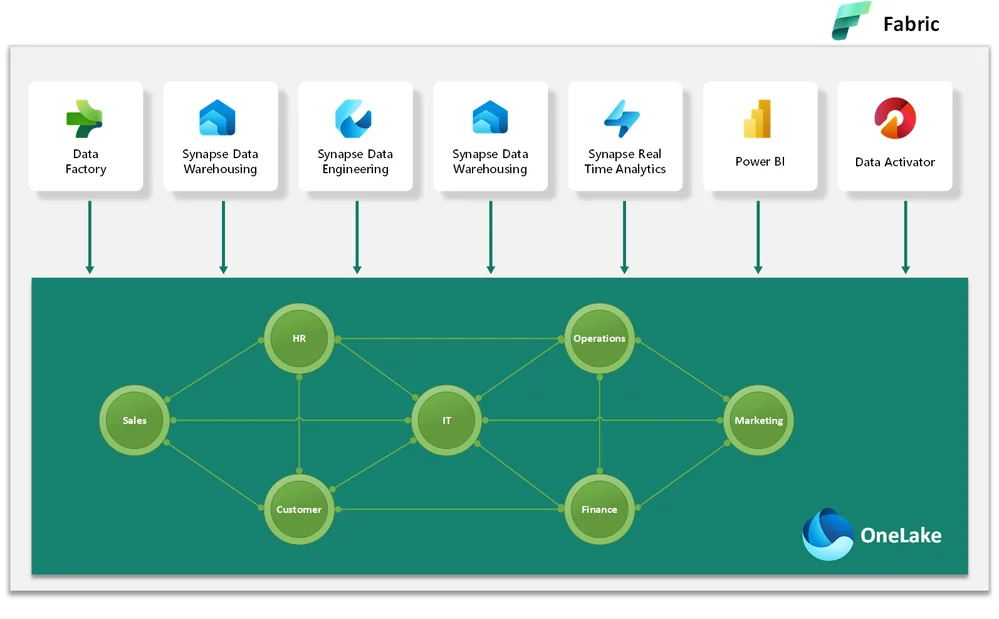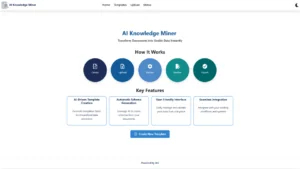Data Mesh represents a paradigm shift in enterprise data management, focusing on decentralization, domain-specific ownership, and treating data as a product. However, as powerful as these principles are, their implementation requires an equally powerful platform. With its unique capabilities and SaaS model, Microsoft Fabric is not just compatible with Data Mesh—it’s a natural fit that enhances and supports each of its core principles.

1. Domain-Oriented Decentralized Data Ownership and Architecture
Data Mesh’s first principle is decentralizing data ownership, allowing domain-specific teams to take control of their data. This decentralization enables teams to manage and process highly relevant data for their business functions, ensuring higher quality and relevance.
Microsoft Fabric’s Alignment
Microsoft Fabric’s workspace and domain organization are designed with this decentralization in mind. Each domain within an organization can create its own workspaces, which act as secure, self-contained environments where teams can manage their data independently. This structure not only aligns perfectly with the decentralized architecture of Data Mesh but enhances it by providing a clear, organized framework that supports domain-specific autonomy while maintaining overarching governance.
2. Data as a Product
Treating data as a product means that each data set or service is managed with the same care and attention as a customer-facing product, focusing on usability, quality, and value. In the context of Data Mesh, this approach ensures that data products are created, maintained, and enhanced to meet the specific needs of their consumers, whether internal teams or external partners.
Microsoft Fabric’s Alignment
Microsoft Fabric’s workspace and domain organization are designed with this decentralization in mind. OneLake Shortcuts allow data to be shared across different domains without duplication, ensuring that the same high-quality data product is accessible to all who need it without the overhead of copying data across systems. This shared access keeps the data consistent and up-to-date across the organization, which is crucial for maintaining the integrity and usability of data products.
Moreover, the Semantic Model in Microsoft Fabric is a contract for data products within the Data Mesh architecture. It defines the meaning, structure, and context of the data, ensuring that all stakeholders understand the data product’s characteristics. This semantic consistency is essential for treating data as a product, as it guarantees that everyone interacting with the data understands its purpose, structure, and usage, leading to better data-driven decisions and more efficient processes.
Additionally, Microsoft Fabric provides a unified platform that caters to both Data Owners and Consumers. Its comprehensive capabilities—from reporting to machine learning—facilitate faster time to market and better integration across domains. This allows organizations to leverage the platform for managing and delivering data products and deriving insights and predictive analytics, accelerating innovation and ensuring that data serves its full potential.
3. Self-Serve Data Infrastructure as a Platform
Data Mesh advocates for a self-serve infrastructure that empowers teams to manage their own data needs independently. This principle is about providing the right tools and platforms so that each domain can operate without being bottlenecked by centralized data teams.
Microsoft Fabric’s Alignment
Microsoft Fabric’s design as a Software-as-a-Service (SaaS) platform is inherently aligned with the self-serve principle. It provides all the necessary tools and resources—like data processing, storage, and analytics—within a single, integrated environment. Teams can easily access and utilize these tools to manage their data needs, reducing dependency on central IT and accelerating the delivery of data insights. This self-service capability is crucial in enabling the agility and responsiveness that Data Mesh aims to achieve.
4. Federated Computational Governance
While Data Mesh promotes decentralization, it also emphasizes the need for governance across domains to ensure compliance, security, and consistency. Federated governance means that while each domain operates independently, there are overarching policies and standards that everyone adheres to.
Microsoft Fabric’s Alignment
Microsoft Fabric excels in supporting federated governance through its robust governance tools. Features like Role-Based Access Control (RBAC) ensure that data access is tightly controlled, with permissions managed at both the domain and organizational levels. Fabric’s data cataloging and OneLake Shortcuts are critical in maintaining governance across decentralized data domains. OneLake Shortcuts allow data to be shared across domains without duplication, ensuring that data remains consistent, secure, and governed according to centralized policies, even as multiple teams access it.
Conclusion: The Complementary Power of Fabric and Data Mesh
Microsoft Fabric isn’t just a tool that fits into a Data Mesh architecture—it’s a platform that enhances and extends the principles of Data Mesh, making it easier for organizations to achieve their data management goals. By providing domain-specific workspaces, supporting a self-service SaaS model, enabling seamless data sharing with OneLake Shortcuts, and ensuring robust governance, Microsoft Fabric allows organizations to implement Data Mesh in a scalable, secure, and aligned with modern data management needs. With built-in support for Continuous Integration and Continuous Deployment (CI/CD), Fabric enhances automation in deployment pipelines, including notebooks and data processes, by leveraging DevOps APIs. This automation accelerates deployment cycles and ensures consistency and reliability across environments, further aligning with the principles of agility and innovation that Data Mesh promotes.
As enterprises continue to evolve and adapt to the complexities of managing vast data ecosystems, integrating Data Mesh with Microsoft Fabric offers a future-proof solution combining both approaches’ strengths. Together, they provide a path forward for organizations looking to harness the full potential of their data, driving innovation and maintaining a competitive edge in an increasingly data-driven world.
To learn more, download our Whitepaper: Revolutionize Enterprise Data Management with Data Mesh and Microsoft Fabric.






